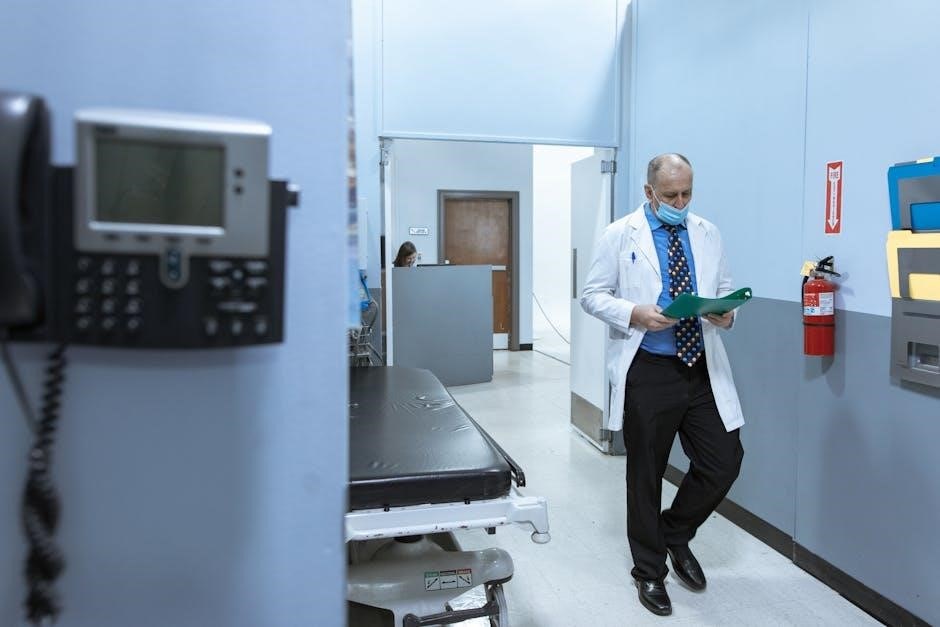expert field medical badge study guide
The Expert Field Medical Badge (EFMB) is a prestigious recognition, established to test a soldier’s ability to perform medical tasks in combat-like conditions. It is crucial for military medics to demonstrate expertise in patient care, trauma management, and field procedures. Earning the EFMB signifies a high level of proficiency and readiness in providing medical support during missions.
Overview of the EFMB
The Expert Field Medical Badge (EFMB) is a prestigious award recognizing medical professionals’ expertise in field operations. It evaluates both theoretical knowledge and practical skills, ensuring readiness for real-world scenarios. The badge is earned through rigorous testing, including written exams, clinical assessments, and physical challenges like the 400-meter run; It validates a medic’s ability to perform under stress, making it a cornerstone of military medical training. The EFMB is essential for ensuring high standards of care in combat environments, reflecting the critical role of medics in mission success.
Importance of the EFMB in Military Medicine
The Expert Field Medical Badge (EFMB) is a cornerstone of military medicine, ensuring medics are proficient in critical skills needed for combat scenarios. It validates their ability to perform under stress, directly impacting mission success and patient outcomes. The EFMB sets a high standard for care in austere environments, ensuring medics are equipped to handle trauma, triage, and field procedures effectively. This badge is not only a professional milestone but also a vital tool for maintaining readiness and delivering quality medical support in deployed settings.
Eligibility Criteria for the EFMB
To qualify for the Expert Field Medical Badge (EFMB), candidates must meet specific criteria. Typically, they must be Army medics or in a medical-related Military Occupational Specialty (MOS); A high level of physical fitness is required, as the test includes a 400-meter run. Candidates must also complete advanced medical training, such as the Combat Medic Specialist course. Additionally, they must demonstrate proficiency in both written and practical exams. Meeting these criteria ensures that only the most capable medics earn the EFMB, reflecting their readiness to provide critical care in challenging field environments.
Understanding the EFMB Test Structure

The EFMB test combines written and practical assessments, evaluating both medical knowledge and hands-on skills. It simulates real-world field conditions to ensure comprehensive competency in military medicine.
Written Test Format and Content
The EFMB written test consists of multiple-choice questions designed to assess a candidate’s knowledge of military medicine, trauma care, and field medical procedures. Topics include patient assessment, wound management, and radiology in deployed settings. The exam also covers infection control, trauma patient evaluation, and the use of medical equipment. Study guides and official training manuals are essential resources for preparation. Candidates must demonstrate a strong understanding of both theoretical and practical aspects of field medicine. Time management and attention to detail are critical for success in this challenging evaluation of medical expertise.

Practical Test Components
The EFMB practical test evaluates hands-on medical skills in simulated combat scenarios. Candidates must demonstrate proficiency in patient assessment, trauma care, and wound management. Tasks include applying tourniquets, administering medications, and using field medical equipment. Communication and documentation skills are also assessed. The practical exam mirrors real-world combat conditions, ensuring medics can perform under pressure. Successful completion requires precision, speed, and adherence to military medical protocols. This component is crucial for verifying a medic’s ability to apply knowledge in high-stress environments, making it a cornerstone of the EFMB evaluation process.
Scoring and Passing Requirements
The EFMB requires candidates to achieve a minimum score of 80% on both the written and practical exams. The written test evaluates knowledge, while the practical assesses hands-on skills. Scoring is based on accuracy, speed, and adherence to military medical protocols. Candidates must also pass a physical fitness test, including a 400-meter run. Successful completion of all components is mandatory for earning the badge. The rigorous scoring ensures only the most competent medics qualify, reflecting the high standards of military medicine. Meeting these requirements demonstrates a medic’s readiness to perform effectively in combat environments.
EFMB Written Test Study Guide
The EFMB Written Test Study Guide provides comprehensive coverage of key topics, including patient assessment, trauma care, and radiology. It offers updated questions and detailed explanations to help candidates prepare effectively for the exam, ensuring readiness for real-world medical scenarios in the field.
Key Topics Covered in the Written Exam
The written exam for the EFMB covers critical areas such as patient assessment, trauma care, and radiology in field settings. It includes questions on wound management, infection control, and hemorrhage control techniques. Additionally, the test evaluates knowledge of medical equipment usage, communication skills, and documentation practices. Topics also encompass radiography basics, imaging techniques for trauma patients, and interpreting radiographs in deployed environments. The exam ensures candidates are well-versed in military medical protocols and field procedures, preparing them for real-world scenarios encountered in combat zones. Staying updated with the latest guidelines is essential for success.
Recommended Study Materials and Resources
Key study materials include the EFMB Written Test Study Guide, which provides updated questions and answers. Official training manuals like AMEDDCS Pam 350-10 offer detailed test preparation. Online resources such as Stuvia US and Course Hero provide comprehensive summaries and practice exams. Additionally, peer-reviewed articles and tutorials on radiology in field settings are essential. Utilizing these resources ensures a thorough understanding of exam topics, from patient assessment to radiography. Combining these materials with hands-on practice and mentorship enhances readiness for the written and practical exams.
Practice Questions and Answers
Practice questions and answers are essential for EFMB preparation, offering insights into exam content and format. Resources like the EFMB Written Test Study Guide provide updated questions with correct answers, covering topics such as patient assessment, trauma care, and medical procedures. These materials help identify knowledge gaps and improve test-taking skills. Regularly reviewing practice questions enhances familiarity with the exam structure and reinforces key concepts. Utilizing verified study guides ensures accuracy and relevance, boosting confidence for the written and practical tests.

Clinical Skills Assessment
The Clinical Skills Assessment evaluates a medic’s ability to perform critical medical procedures under field conditions, focusing on patient assessment, wound management, and trauma care effectively.
Patient Assessment and Triage
Patient assessment and triage are critical skills evaluated during the EFMB. Medics must quickly evaluate patients, prioritize care based on injury severity, and allocate resources effectively. This process ensures timely treatment for critical cases while managing less severe injuries. Proper assessment involves identifying life-threatening conditions, such as bleeding or respiratory distress, and stabilizing patients for further care. Triage skills are essential in combat scenarios where medical resources may be limited. The EFMB test simulates real-world conditions to verify a medic’s ability to make swift, accurate decisions under pressure, ensuring optimal patient outcomes in high-stress environments.
Wound Management and Infection Control
Wound management and infection control are essential skills for EFMB candidates. Proper wound assessment, cleaning, and dressing are critical to prevent infection and promote healing. Medics must use sterile techniques and apply appropriate dressings or tourniquets to control bleeding. Infection control measures, such as using antibiotics and antiseptics, are vital in field environments where resources are limited. Effective wound care ensures patient stability and reduces the risk of complications. Proficiency in these areas is a key component of the EFMB test, reflecting real-world scenarios where immediate and accurate care is necessary to save lives.
Trauma Care and Hemorrhage Control
Trauma care and hemorrhage control are critical components of the EFMB, focusing on immediate actions to stabilize injured patients. Medics must master techniques like tourniquet application, hemostatic agent use, and wound packing to control severe bleeding. Proper assessment of trauma patients, including identifying life-threatening injuries, is essential. The EFMB test emphasizes these skills, as they are vital in combat scenarios where rapid intervention is crucial. Proficiency in trauma care ensures medics can effectively manage casualties, preventing further complications and improving survival rates in high-stress environments.
Practical Exam Preparation
Practical exam preparation involves hands-on training, simulating real-world medical scenarios. Medics practice patient assessment, wound management, and equipment use under stress, ensuring readiness for field conditions.
Medical Task Simulation and Evaluation
Medical task simulation and evaluation are critical components of EFMB preparation. These exercises replicate real-world combat scenarios, allowing medics to practice patient assessment, trauma care, and equipment use under stress. Evaluators assess proficiency in performing tasks such as wound management, hemorrhage control, and triage. Simulations test decision-making, technical skills, and adherence to protocols. Successful completion demonstrates a medic’s ability to provide effective care in high-stress environments, ensuring readiness for combat situations. These simulations are essential for identifying areas needing improvement before the final exam.
Use of Medical Equipment in the Field
The proper use of medical equipment is vital for EFMB candidates, as it directly impacts patient care in combat scenarios. Medics must demonstrate proficiency with tools like tourniquets, hemostatic agents, and portable diagnostic devices. Understanding equipment functionality ensures effective treatment of injuries, such as controlling hemorrhages or managing airway obstructions. Familiarity with medical kits and devices is tested during simulations, where soldiers must apply their knowledge under stress. Proper equipment usage is critical for saving lives and maintaining operational readiness in deployed environments. Training emphasizes hands-on practice to build confidence and competence.
Communication and Documentation Skills
Effective communication and precise documentation are critical for EFMB candidates, ensuring clear conveyance of patient information in high-stress environments. Accurate documentation is essential for maintaining continuity of care and legal accountability. Medics must master standardized terminology and reporting formats to communicate effectively with team members and higher echelons. Proper documentation includes detailed patient assessments, treatments, and evacuation details. Communication skills are tested during practical exercises, where soldiers must articulate findings clearly. Strong communication enhances teamwork and operational efficiency, while accurate documentation ensures seamless patient care transitions. These skills are vital for success in the EFMB evaluation process.

Radiology and Imaging in Field Settings
Radiology and imaging in field settings involve using portable equipment to assess trauma patients. Medics must interpret radiographs accurately under stress, ensuring timely and effective treatment decisions.
Basics of Radiology in Deployed Environments
In deployed settings, radiology relies on portable equipment like X-ray machines to assess injuries. Medics must understand radiation safety, image acquisition, and interpretation. Accurate radiograph reading is critical for diagnosing fractures, chest injuries, and abdominal trauma. Training emphasizes identifying normal vs. abnormal findings, ensuring timely treatment decisions. Proper positioning and technique are essential for clear images, even in challenging field conditions. This skill is vital for providing effective care in combat zones, where access to advanced imaging is limited.
Imaging Techniques for Trauma Patients
Imaging techniques for trauma patients in field settings focus on quickly identifying life-threatening injuries. Portable X-ray machines are commonly used to assess fractures, chest injuries, and abdominal trauma. Ultrasound is also employed for evaluating internal injuries and bleeding. These methods allow medics to prioritize care and stabilize patients effectively. Proper imaging ensures accurate diagnoses, guiding immediate treatment decisions. Training emphasizes mastering these techniques to enhance patient outcomes in combat zones, where advanced imaging resources are often unavailable. Efficient use of available tools is critical for saving lives in high-stress environments.
Interpreting Radiographs in the Field
Interpreting radiographs in the field is crucial for diagnosing injuries quickly and accurately. Medics use portable X-ray machines to assess fractures, chest trauma, and abdominal injuries. Training emphasizes identifying signs of internal bleeding, fractures, and other life-threatening conditions. A systematic approach to reading radiographs ensures timely and accurate diagnoses. In high-stress environments, medics must remain focused to prioritize care effectively. Proficiency in radiograph interpretation is vital for saving lives in combat zones, where advanced imaging resources are often unavailable. This skill is a cornerstone of the EFMB, ensuring medics can provide critical care under challenging conditions.
Training and Resources
Official training manuals, online courses, and peer-to-peer learning are essential resources for EFMB preparation, providing comprehensive guidance and practical insights for success.
Official Training Manuals and Guides
The AMEDDCS Pam 350-10 Training manual is a primary resource for EFMB preparation, detailing test structure, clinical skills, and practical tasks. It provides in-depth guidance on medical procedures, patient assessment, and field equipment usage. This official document outlines the essential competencies required for the badge, ensuring candidates understand the evaluation criteria. Available as a free PDF, it is a vital tool for aligning study efforts with test expectations, offering clear instructions and standards for success in the EFMB program.
Online Courses and Tutorials
Online courses and tutorials provide structured learning pathways for EFMB candidates, covering critical topics like trauma patient evaluation and radiology imaging. Platforms such as Course Hero offer study guides, including the EFMB Digital Written Test Study Guide, which focuses on radiology in deployed settings. These resources complement traditional study materials, offering interactive learning experiences. They are designed to enhance understanding of field medical procedures, ensuring candidates are well-prepared for both written and practical exams. Accessible and comprehensive, these tools are invaluable for modern learners aiming to excel in the EFMB program.
Peer-to-Peer Learning and Mentorship
Peer-to-peer learning and mentorship are vital components of EFMB preparation, fostering collaboration and shared knowledge among candidates. Experienced medics often mentor less experienced soldiers, providing insights and practical tips for mastering medical tasks. Study groups and informal discussions allow candidates to review challenging topics, such as trauma care and radiology, in a supportive environment. This collaborative approach enhances understanding, builds confidence, and ensures a well-rounded preparation for both written and practical exams. Mentorship programs also emphasize real-world application, helping candidates connect theoretical knowledge with field scenarios.

Physical Fitness and Endurance
Physical fitness is crucial for the EFMB, requiring endurance and strength to perform medical tasks in challenging field conditions, ensuring mission readiness and effectiveness.
Importance of Physical Conditioning
Physical conditioning is essential for EFMB candidates, as it ensures they can perform demanding medical tasks in challenging field environments. Soldiers must build endurance, strength, and stamina to handle the physical demands of combat scenarios, such as carrying heavy equipment and moving patients. The 400-meter run is a key component of the EFMB test, requiring candidates to demonstrate cardiovascular fitness. Proper physical training enhances mission readiness, allowing medics to focus on providing critical care under stress. Neglecting physical conditioning can hinder performance, making it a cornerstone of EFMB preparation and success.
Training for the 400-Meter Run

Training for the 400-meter run is a critical component of EFMB preparation, as it assesses cardiovascular fitness and stamina. Candidates should incorporate interval training, sprinting, and endurance exercises into their regimen. Gradually increasing speed and distance helps build stamina. Strength training for leg muscles is also essential to improve running efficiency. Consistent practice and proper rest are vital to avoid injuries. The goal is to meet the EFMB’s rigorous standards, ensuring readiness for the physical demands of field medical operations. A well-structured training plan is key to achieving success in this challenging event.
Building Endurance for Field Tasks
Building endurance is essential for EFMB candidates to handle the physical demands of field medical operations. A combination of aerobic exercises, strength training, and simulated field tasks helps improve stamina. Incorporating interval training, long-distance runs, and obstacle courses mimics real-world scenarios. Proper hydration, nutrition, and rest are crucial to sustain energy levels. Consistent practice enhances muscular endurance, enabling medics to perform tasks like casualty carries and equipment transport efficiently. Endurance training ensures medics can operate effectively in challenging environments, maintaining peak performance during critical missions. A structured fitness plan is vital to meet the EFMB’s physical requirements successfully.

Test-Taking Strategies
Effective test-taking strategies for the EFMB include time management, understanding question formats, and staying calm. Practice with sample questions improves familiarity and reduces anxiety during exams.

Time Management During the Exam
Effective time management is crucial for success in the EFMB exam. Allocate time wisely for each section, skimming questions to identify priorities. Practice with sample questions to improve speed and accuracy. Focus on high-probability topics and avoid spending too long on a single question. Use the process of elimination to narrow down answers. Stay calm and systematic, ensuring all questions are attempted. Proper time management reduces stress and maximizes scoring potential. Regular practice with timed mock exams helps build confidence and efficiency.
Approaching Multiple-Choice Questions
When tackling multiple-choice questions on the EFMB exam, read each question carefully and identify key terms. Eliminate obviously incorrect answers first to narrow down options. Focus on the most common medical scenarios and procedures, as these are frequently tested. Practice with sample questions to recognize patterns and improve decision-making speed. Avoid guessing unless necessary, as incorrect answers may impact your score. Stay calm and methodical, ensuring you understand each question before selecting an answer. Regular practice with timed mock exams enhances your ability to approach questions confidently and efficiently.
Managing Stress and Anxiety
Managing stress and anxiety is crucial for EFMB candidates to perform optimally. Practice relaxation techniques like deep breathing and positive visualization to stay calm. Familiarize yourself with the exam format to reduce uncertainty. Stay focused on one question at a time and avoid overthinking. Maintain a steady pace and allocate time wisely. Remember, stress can impair decision-making, so train your mind to remain composed. Regular practice and mock exams help build confidence and reduce anxiety. Stay hydrated, well-rested, and mentally prepared to approach the test with clarity and determination.
Common Mistakes to Avoid
- Poor time management during exams can lead to incomplete tasks.
- Misuse of medical equipment may result in incorrect treatment.
- Inaccurate documentation can cause serious patient care issues.

Errors in Patient Assessment
Accurate patient assessment is critical in field medical care. Common errors include rushing the evaluation, failing to identify red flags, and neglecting to reassess after treatment. Misdiagnosing injuries or conditions can lead to inappropriate care. Overlooking vital signs or neurological changes is another frequent mistake. Additionally, improper use of assessment tools or techniques can result in incomplete or inaccurate data. These errors can compromise patient outcomes and mission success. Proper training and adherence to protocols are essential to minimize such mistakes and ensure effective care in high-stress environments.
Misuse of Medical Equipment
Misuse of medical equipment is a critical error that can compromise patient care and mission success. Common issues include improper use of tourniquets, hemostatic agents, or IV equipment. Failure to follow manufacturer guidelines or lack of familiarity with devices can lead to ineffective treatment. Additionally, neglecting to maintain or inspect equipment can result in malfunction. Proper training and hands-on practice are essential to ensure correct usage. Adhering to established protocols and staying updated on equipment advancements can minimize such errors and enhance overall medical response in field settings.
Documentation Oversights
Documentation oversights are a frequent issue during the EFMB assessment, often leading to missed points. Common errors include incomplete patient records, illegible handwriting, and failure to document vital signs or treatment steps. Such oversights can result in inaccurate patient histories and legal complications. To avoid this, candidates should use standardized documentation templates and ensure all entries are clear, concise, and timestamped. Double-checking documentation for completeness and accuracy is crucial. Proper documentation not only ensures continuity of care but also reflects professionalism and attention to detail, both of which are critical for success in the EFMB evaluation.
The EFMB represents excellence in military medicine, validating a medic’s ability to deliver critical care in challenging environments. Earning it is a mark of dedication and skill.
Final Tips for Success
To excel in the EFMB, thoroughly study official guides and practice with updated questions. Focus on mastering practical skills like patient assessment and trauma care. Regularly review radiology techniques and medical equipment usage. Prioritize physical conditioning to build endurance for field tasks. During the exam, manage time effectively and approach multiple-choice questions with confidence. Stay calm, avoid common mistakes, and ensure accurate documentation. Continuous learning and peer mentorship can enhance preparation. Success in the EFMB reflects dedication to military medicine and readiness to provide critical care in challenging environments.
Continuous Learning and Improvement
Continuous learning is essential for maintaining expertise in military medicine. Soldiers should regularly review official training manuals and participate in online courses to stay updated on medical protocols. Engaging in peer-to-peer learning and mentorship fosters a collaborative environment for skill refinement. Practicing with updated study guides and practice questions ensures familiarity with exam content. Self-assessment and identifying knowledge gaps are critical for targeted improvement. By committing to lifelong learning, medics enhance their proficiency, ensuring they remain capable of providing high-quality care in demanding field environments. This dedication strengthens the foundation of military medicine and the EFMB’s legacy.
The Role of the EFMB in Military Medicine
The Expert Field Medical Badge (EFMB) plays a vital role in military medicine by setting a high standard of proficiency for medical professionals. It ensures medics are skilled in critical tasks, such as trauma care and patient assessment, under challenging conditions. The EFMB validates a medic’s ability to operate effectively in combat environments, directly contributing to mission success and patient survival. By earning the EFMB, medics demonstrate their commitment to excellence, enhancing the overall quality of military medical care and upholding the integrity of the Army’s medical mission.
